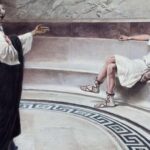We explain what it means memento mori and in what types of artwork it was used in the Middle Ages. Also, other famous phrases in Latin.

What does it mean memento mori?
Memento mori It is a Latin phrase or phrase that translates into Spanish as “remember that you will die.” or “remember that you are mortal”, and whose historical origin is uncertain. It is thought to have been used in Ancient Rome to remind victorious Roman generals that they were nothing more than human, and thus prevent them from incurring pride. However, in the writings of Church Father Tertullian (c. 160-c.220), it is stated that the phrase in question was “Respice post te! Hominem te esse memento!” (“Look behind you! Remember that you are (barely) a man!”).
Whatever its origin, this phrase It was used widely in the Christian Middle Ages, as a reminder of the transience of life, in statues, works of art and objects that represented death especially in tombs and cemeteries, along with the phrases Fugit time (“The hour is ticking”) or Tempus fugit (“Time flies”). In fact, between 1300 and 1600, funerary art in Europe produced four main archetypes of memento mori or monument to death:
- the dance of death which showed a group of people dancing with a skeleton or to the music of a skeleton, and which compared the brevity of life to a dance piece. He used the skeleton to show that the end of life is always the same: death.
- The victory of death which showed a skeleton or hooded figure wielding different weapons over the defeated figure of a human warrior, or a skeleton driving a Roman war chariot drawn by animals. In both cases, the aim was to represent the final victory of death over all human beings, no matter how strong or important they are.
- The double monuments typical of funeral monuments of the nobility, which showed in the upper plane the figure of the deceased with his royal clothing and attire, while in the lower part they showed the body in decomposition, alluding to the egalitarian nature of death, which reaches nobles and commoners alike.
- The meeting of the three living and the three dead a recurring theme in medieval art and present in most of the Books of hourswhere they served as an illustration to different prayers for the souls of the deceased. It is about three well-dressed hunters who go out hunting and find or are attacked by three corpses. It is interpreted as an allusion to the impossibility of escaping death: each hunter inevitably gets his own.
These artistic representations were generally accompanied by the inscription memento moriand they were so common that they collectively acquired that same name. This inscription can also be found in prayer and religious education books and today it has become a popular motif for tattoos, graffiti and titles of literary or cinematographic works.
However, its current interpretation differs from that originally given by the Romans and Christian priests: It is often interpreted as a reminder that every moment should be lived to the fullest or that the pleasures of life should not be resisted, since existence is short and death is certain.
See also: Day of the Dead
Other well-known Latin phrases
Other phrases of Latin origin that are popular today are the following:
- Alea iacta est (“the die is cast”). This is a verse from Menander that is attributed to the Roman leader Julius Caesar, when in Gaul he ordered his troops to cross the Rubicon River. It is used when a risky decision is made without return or regret, in a way similar to “let it be what God wants.”
- Love omnia vincit (“love overcomes all”). This is a verse from Eclogue Bucolica set of pastoral poems by the Roman poet Virgil. It is interpreted as saying that love can do anything, regardless of the circumstances, since it is an insurmountable force.
- Carpe diem quam minimum credula postero (“seize the day by trusting as little as possible in tomorrow”). This is a verse by the Roman poet Horace, often abbreviated to “carpe diem”. It is more or less equivalent to “don't put off until tomorrow what you can do today”, that is, a reminder that the present time is the only thing under our control.
- Orandum est ut sit mens sana in corpore sana (“Pray for a healthy mind in a healthy body”). This is a quote from Satires by the Roman comic poet Juvenal, often abbreviated to “healthy men in healthy corpore”. Although in Ancient Rome it was considered a joking phrase, today it survives as the motto of many gymnastics and sports clubs, and is interpreted as a call to balance the strength of the mind and emotions with that of the body.
- Errare humanum est, sed perseverare diabolicum (“It is human to make mistakes, but diabolical to insist on error”). Often abbreviated in its first part (“I will err humanum est“), this phrase is attributed to Seneca the Younger, but it does not appear in any of his works, so it is also thought that it could be a bad translation of the Controversies of Seneca the Elder, or even of the Philippics from Cicero, where there are similar sentences. It is interpreted as saying that everyone is fallible, capable of making mistakes, but that it is very foolish to insist on a mistake that has already been made.
- Primum non nocere (“the first thing is not to hurt”). Phrase used in medical and therapeutic fields since the 19th century, but of uncertain origins. It is attributed to the Greek Hippocrates, but contrary to popular belief, it does not appear in any of the versions of the Hippocratic Oath, so it may be a version or a paraphrase by the Roman Galen of some lost phrase of Hippocrates. In any case, it is interpreted as meaning that, above all, the duty of doctors is not to cause the patient more suffering than he had before being treated.
- Nosce te ipsum (“know thyself”). It is an aphorism of uncertain origin, a Latin translation of the Greek form Gnothi seautonof the same meaning, and which according to the Greek historian and geographer Pausanias appeared at the entrance to the Oracle of Delphi, to which the ancient Greeks made pilgrimages in search of advice. The phrase has been erroneously attributed to numerous philosophers and sages of Antiquity, and is interpreted today as an invitation to understand the way each person is, as a first step in relating to the world and others.
- Deus ex machina (“the god who descends from artifice”). This is the Latin translation of the Greek phrase apó mechanes theosemerged in the context of ancient Greek theater, in which it was common for a machine or set of pulleys to introduce an actor representing a God from offstage, and whose entry into the play resolved some conflict as if by magic . The expression was preserved over time and is used in the world of literary and film criticism to name those devices that resolve the plot of the work without adhering to its logic, and which are therefore considered deceitful and lackluster.
- Cogito ergo sum (“I think, therefore I exist”). This is a famous phrase by the French Renaissance philosopher René Descartes, the fundamental motto of Rationalism, found in his Discourse of the method from 1637. The phrase means that the main evidence of one's own existence is the human being's ability to think, and therefore existence is undoubted and serves as a basis for the establishment of new certainties about the world. The phrase is often translated as “I think, therefore I am,” but this formulation lends itself to ambiguity and the misinterpretation that the human being first thinks and then exists, which is naturally impossible, since one cannot think without first. exist.
Continue with: Myth of Plato's Cave
References
- “Latin locutions” on Wikipedia.
- “Memento mori” at Encyclopedia.com.





